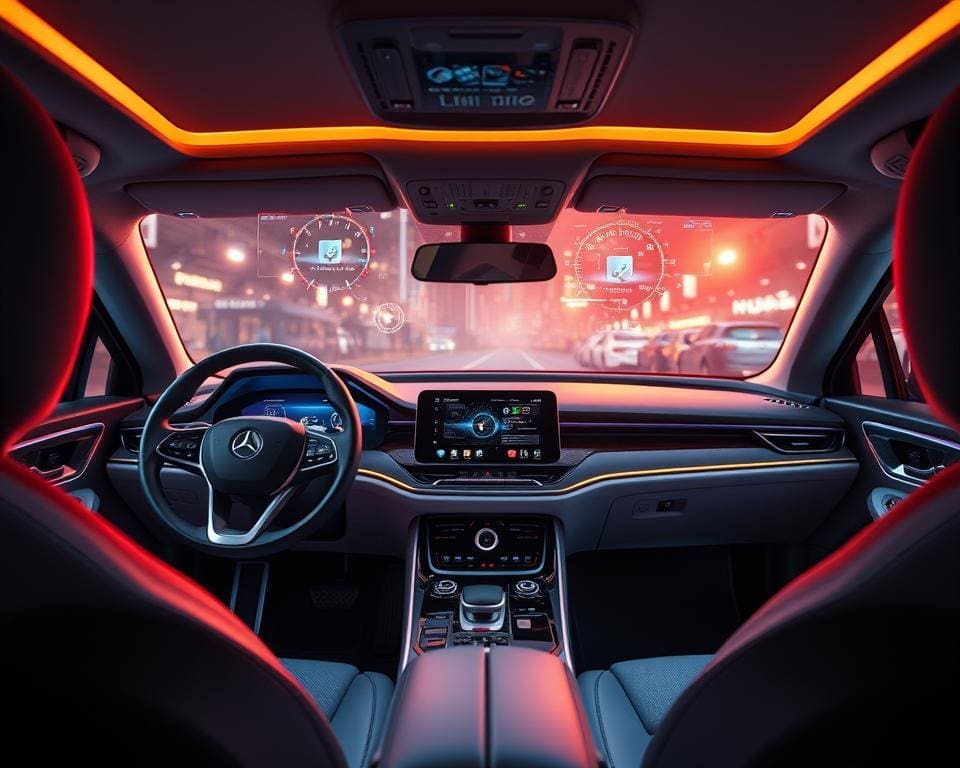The rise of In-Car AI heralds a transformative era for the vehicle user experience. With cutting-edge technologies woven into the fabric of modern automobiles, drivers and passengers alike are encountering unprecedented levels of convenience, safety, and entertainment. From enhancing navigation systems to incorporating the Automotive AI Assistant, these innovations are reshaping how we interact with our vehicles. As we delve deeper, it becomes evident that In-Car AI is not merely an addition; it is a revolutionary leap towards a more connected and intuitive driving experience.
Understanding In-Car AI and Its Impact
In-Car AI represents a significant evolution in the automotive industry, bringing forth an array of functionalities that enhance the driving experience. This technology embodies a range of capabilities including voice recognition, predictive algorithms, and seamless connectivity, all designed to improve vehicle user experience. The integration of intelligent systems not only enriches interactions between drivers and their vehicles but also sets a new benchmark for convenience and safety on the road.
Defining In-Car AI
At its core, In-Car AI refers to the artificial intelligence systems embedded in vehicles that facilitate a more intuitive and responsive driving experience. This includes features like voice-activated commands, enabling users to control various functions without taking their hands off the wheel. Moreover, AI-driven predictive algorithms learn from user behaviour, adapting to individual preferences and enhancing the overall interaction. Such advancements signify a monumental shift from traditional driving, making the experience more personalised and engaging.
The Role of AI-based Automotive Technology
AI-based automotive technology plays a pivotal role in reimagining the everyday experience of driving. It streamlines various vehicle functions, allowing for smoother operation and interaction. Key aspects include:
- Enhanced safety through real-time monitoring and alerts
- Optimisation of fuel efficiency and performance
- Improvement of navigation systems with dynamic routing capabilities
With the continuous integration of such technologies, In-Car AI is not merely an addition but a transformation of vehicle user experience, ushering in a future where automobiles become smarter, safer, and more enjoyable to drive.

Intelligent In-Vehicle Systems: A New Era
The advent of Intelligent In-Vehicle Systems marks a pivotal shift in the landscape of in-car technology. These systems comprise several integrated components that collectively enhance the vehicle user experience, providing an array of functionalities that were previously unimaginable. Understanding the intricate parts that constitute these systems offers insight into their importance and the benefits they deliver.
Components of Intelligent In-Vehicle Systems
Intelligent In-Vehicle Systems are built upon a foundation of various elements that work harmoniously together. These include:
- Sensors: Essential for gathering data from the vehicle’s environment, enabling real-time responsiveness.
- Software: Powers the systems, allowing for updates and improvements to user interfaces and functionalities.
- Hardware Optimisation: Ensures that components are efficient and reliable, enhancing overall performance.
Benefits of Intelligent In-Vehicle Systems
The implementation of these systems introduces numerous advantages, significantly impacting both drivers and passengers. Key benefits include:
- Enhanced Safety Features: Advanced sensors and software can identify potential hazards, actively contributing to accident prevention.
- Improved User Engagement: The intricate systems improve interaction through personalised experiences, catering to individual preferences.
- Greater Fuel Efficiency: Intelligent systems analyse driving patterns, offering suggestions that optimise fuel consumption.
In-Car AI: Transforming Vehicle User Experience
In-Car AI sets a new standard for vehicle comfort and convenience, redefining the way users interact with their automotive experience. By employing intelligent systems, manufacturers enhance various vehicle functionalities, creating an environment where commands are executed seamlessly and intuitively.
Enhancing Comfort and Convenience
The incorporation of In-Car AI allows for effortless operation of numerous features. Users can control climate settings, navigation, and entertainment systems through simple voice commands or touch interfaces, minimising distractions while driving. Such innovations transform mundane tasks into enjoyable interactions, ensuring a more comfortable journey.
Integrating AI with Vehicle Functionality
Leading brands like Tesla and Mercedes-Benz showcase the potential of merging AI with vehicle functions. Their systems adapt to user preferences, adjusting settings based on past behaviours and providing a personalised driving experience. This integration of intelligent systems fundamentally improves comfort and accessibility, making each automotive experience truly memorable.
Smart Car Tech: Features That Stand Out
As the automotive industry evolves, smart car tech brings innovative features that redefine the driving experience. Among these advancements, exceptional voice recognition, powered by natural language processing, enables seamless interaction between driver and vehicle. This technology not only enhances convenience but also promotes safety on the road.
Voice Recognition and Natural Language Processing
Modern vehicles increasingly utilise voice recognition capabilities that allow drivers to control various functions without taking their hands off the wheel. Advanced systems from manufacturers such as Mercedes-Benz and Ford exhibit how voice commands can adjust climate settings, play music, or navigate without distraction.
Natural language processing is at the heart of this technology, allowing the vehicles to understand user intent effectively. Drivers experience a more intuitive way to interact, making driving safer and more enjoyable.
Adaptive Navigation and Route Planning
Navigation technology has transformed with adaptive systems that provide dynamic routing based on real-time conditions. Vehicle manufacturers like Tesla and BMW feature advanced navigation that re-evaluates routes in response to traffic, weather, and road closures, ensuring a smoother journey.
This smart car tech not only saves time but enhances the driving experience by integrating seamless updates. This fusion of technology and driving signifies a remarkable stride towards a future where vehicles understand and adapt to the needs of their users, showcasing the potential of smart car technology today.
The Connected Car Experience
The evolution of automotive technology has profoundly transformed the connected car experience. With smart devices becoming an integral part of our lives, vehicles now offer seamless connectivity that enhances every journey. This integration allows drivers and passengers to engage more fully with their surroundings, making road travel not just a necessity, but a pleasure.
Seamless Connectivity with Smart Devices
Modern vehicles equipped with AI connectivity ensure that smart devices can sync effortlessly, providing a unified ecosystem for users. This harmony between vehicle systems and mobile technology delivers significant benefits, such as:
- Access to navigation services through familiar mobile interfaces.
- Integration with smart home devices for a cohesive daily routine.
- Entertainment options that stream directly from personal devices.
The ability to manage and control various aspects of the car through smart devices amplifies convenience, allowing for an experience that adjusts to individual preferences.
Real-time Updates and Information Sharing
Real-time updates continue to redefine the driving experience. Information such as live traffic conditions, weather alerts, and even local event notifications become readily available without disrupting the journey. This capability enhances safety by providing timely warnings about road hazards or delays, while also making the experience more engaging.
With the help of connected services, drivers benefit from:
- Timely rerouting suggestions based on current traffic patterns.
- Seamless transitions from work tasks to leisure activities.
- Enhanced social interactions through seamlessly shared media and experiences.
The connected car experience marks a significant shift, promising a future where driving is marked by intelligence, convenience, and enjoyment.
Next-Gen Vehicle Technology and Safety
The emergence of next-gen vehicle technology is fundamentally reshaping automotive safety. With a focus on AI in safety systems, innovations in collision avoidance mechanisms are becoming the norm rather than the exception. These technologies underscore a commitment to reducing road incidents and enhancing the driving experience.
AI in Collision Avoidance Systems
Utilising advanced algorithms, AI in collision avoidance systems plays a pivotal role in recognising objects, analysing speeds, and predicting potential accidents. This intelligent technology allows vehicles to react faster than humans, enabling:
- Real-time monitoring of the vehicle’s surroundings
- Accurate detection of pedestrians and other vehicles
- Automatic emergency braking to mitigate impacts
Such innovations are essential components of next-gen vehicle technology that focus on proactive measures to enhance safety on the roads.
Enhancing Driver Assistance Features
The integration of driver assistance features reflects a transformative approach to driving. These features, supported by cutting-edge AI, ensure a safer experience through:
- Lane keeping assistance, which aids drivers in maintaining proper positioning on the road
- Adaptive cruise control that adjusts speed based on traffic conditions
- Blind spot detection systems that alert drivers to obstacles
Such advancements not only bolster the effectiveness of driver assistance but also inspire confidence in technology’s ability to protect lives. As the automotive industry embraces these innovations, the future of road safety looks increasingly promising.
The Automotive AI Assistant: Personalisation at Its Best
The automotive AI assistant stands at the forefront of customised driving experiences. It leverages advanced technologies to enhance user interaction through effective personalisation. By analysing individual behaviours and preferences, this innovative assistant transforms how drivers engage with their vehicles.
Customising User Preferences
Incorporating the automotive AI assistant allows for remarkable personalisation tailored to each user. It can remember favourite routes, adjust seat positions, and even modify climate settings based on past choices. The result is a seamless experience that offers increased comfort and satisfaction while driving. Key features include:
- Voice commands that adapt to user-specific language styles.
- Dynamic recommendations for music or navigation based on previous interactions.
- Learning algorithms that improve over time, ensuring more accurate adjustments with each journey.
AI-powered Predictive Maintenance
Beyond personalisation, the automotive AI assistant plays a crucial role in predictive maintenance. By continually monitoring vehicle performance and analysing patterns, it identifies potential issues before they escalate. This proactive approach offers numerous advantages, such as:
- Reduced repair costs by addressing minor problems early on.
- Enhanced vehicle longevity through regular maintenance reminders.
- Increased safety for drivers and passengers alike, as reliability improves.
Future Trends in In-Car AI and User Experience
The realm of In-Car AI is set to evolve dramatically in the coming years, with future trends hinting at unparalleled enhancements in vehicle user experience. As automotive manufacturers invest heavily in AI-driven technologies, consumers will witness innovative features that elevate comfort, safety, and connectivity. With the advent of 5G technology, real-time communication between vehicles and infrastructure is expected to significantly enrich the driving experience, offering seamless navigation and proactive traffic management systems.
Moreover, personalisation through advanced machine learning algorithms will enable vehicles to understand preferences on a deeper level, adapting not just to driving habits, but also to lifestyle choices and routines. The integration of health-monitoring systems within vehicles can revolutionise the way we perceive safety, making it possible to detect signs of fatigue or distraction, thereby preemptively offering alerts or assistance.
As we look ahead, the landscape of automotive design and functionality will likely embrace eco-friendly technologies, and next-gen interfaces equipped with augmented reality. Such advancements will not only enhance user experience but also align with growing environmental consciousness among consumers. In summary, as we forge into this exciting future, In-Car AI is positioned to redefine how we interact with our vehicles, ensuring they cater to both our needs and aspirations, ultimately transforming the very essence of the vehicle user experience.









